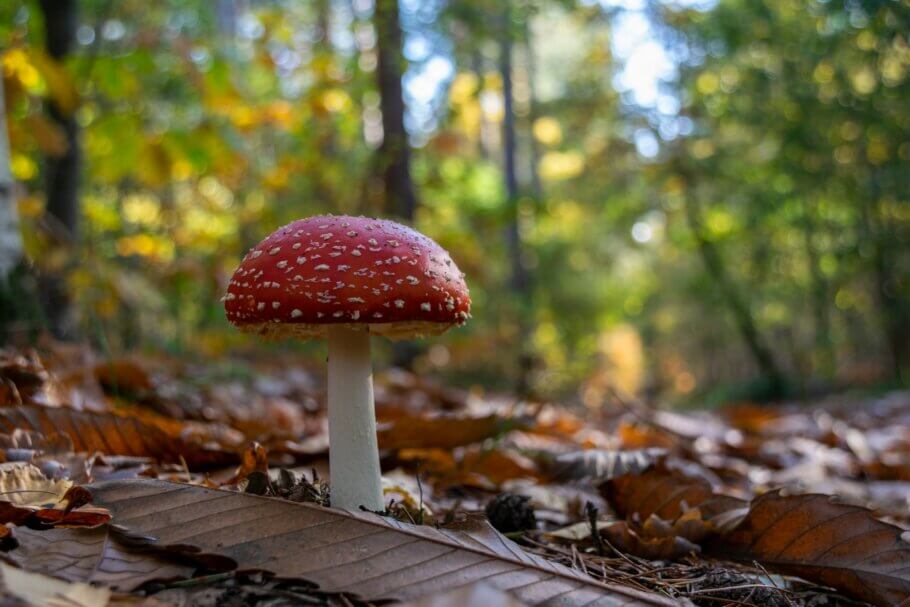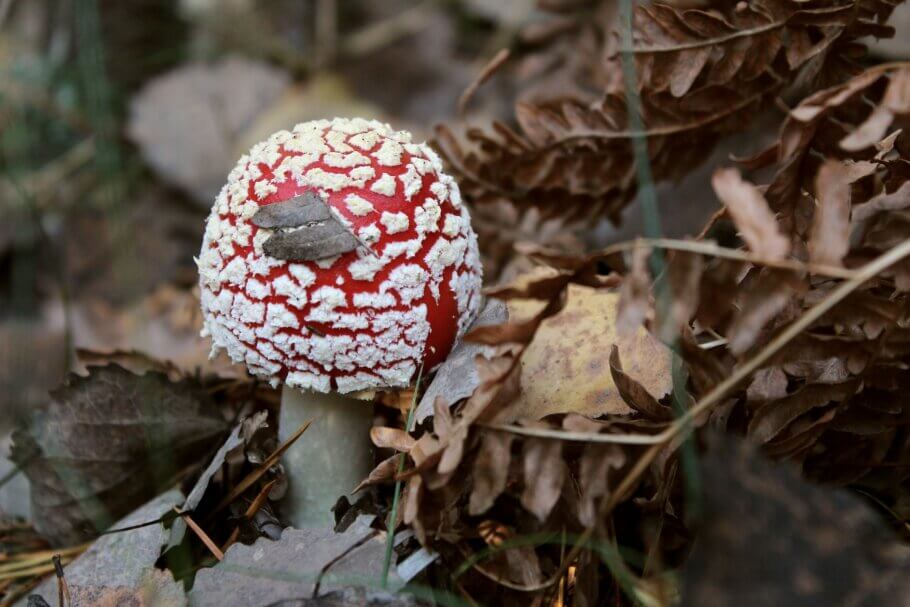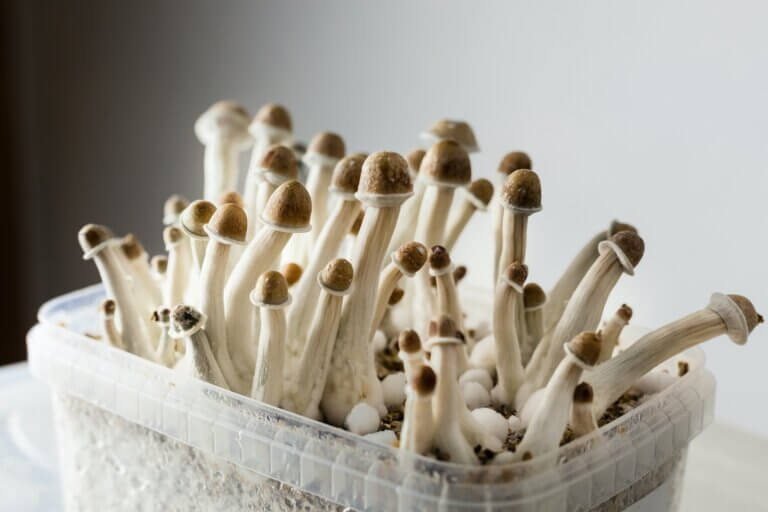In the corners of the forests and under the shade of the trees, there is a peculiar mushroom that has captivated the imagination of ancient and modern cultures, and that surprises everyone who finds it; The Amanita muscaria, known for its striking colors and links to mythology, houses within it a fascinating substance to which today we will dedicate this article, muscimol.
This psychoactive compound has been the subject of interest and mystery, taking those who explore its effects on a unique journey into the mind. Join us on this journey into the world of muscimol, as we unravel its secrets and explore the experiences offered by this magical mushroom and its main psychotropic component.

Amanita Muscaria, the queen of the forest
Among the variety of magic or hallucinogenic mushrooms that can be found in nature, and leaving aside the famous psilocybin mushrooms, the genus known as Amanita includes a series of basidiomycete mushrooms of the order Agaricales. This genus includes more than 600 known species of mushrooms, from edible species appreciated in the kitchen to some of the most toxic in the world. It must be said that the majority of mushrooms of this species are toxic, so if you want to use them as an ingredient in cooking it is important to know how to distinguish them without any doubt.
If we focus on the mushrooms classified as toxic within this genus, Amanita muscaria is one of the best-known and most common in the shady corners of our forests. This mushroom, shrouded in mystery and exhibiting its vibrant colors, stands as one of the most emblematic figures that fungal flora offers us. But…where does this fantastic mushroom choose to reveal itself? Well, it is under leafy tree canopies and among the leaf litter of boreal and coniferous forests where the Amanita muscaria displays its elegant scarlet hat, dotted with its characteristic white spots, capturing the imagination of those who encounter it.
With its unmistakable characteristics, the Amanita muscaria has an appearance that seems straight out of a fairy tale: a convex cap, scalloped edges, and colors that range from deep red to bright orange. Contrasting white spots add a touch of magic to your look. But what secrets does this charming mushroom keep? Why and how has it captured the attention of explorers and storytellers over the centuries? Well, apart from its spectacular appearance, without a doubt one of the characteristics that have made it a mythical mushroom is its muscimol content, the main psychoactive substance present in this mushroom and responsible for its powerful psychotropic effects.

What is Muscimol?
Muscimol (also called 5-(Aminomethyl)-isoxazol-3-ol) is a psychoactive alkaloid found mainly in certain species of mushrooms, with Amanita muscaria being one of the best-known sources of this compound. This substance has hallucinogenic and sedative properties, triggering psychedelic experiences in those who consume this type of mushrooms. It is, therefore, together with ibotenic acid, the main responsible for the intense psychoactive effect of these mushrooms. Although the properties of this mushroom have been known since ancient times, within the Western scientific field it was in 1730 when FJ Strahlenberg, a prisoner held in Siberia, observed how his fellow Koryak prisoners, from the Kamchatka peninsula, used Amanita muscaria as a source of evasion of the harsh conditions they had to endure.
In fact, for quite a long time the psychoactive qualities of this mushroom were attributed to muscarine, an alkaloid that causes symptoms such as overheating, intestinal discomfort, or disorientation in the user, but in no case visionary experiences as its consumers attested. Much later, in the 1960s, researchers in Switzerland and Japan independently discovered that the active ingredients responsible for these powerful entheogenic effects were ibotenic acid and muscimol. Ibotenic acid is considered a neurotoxin that, when decarboxylated, becomes muscimol, our protagonist today.

How does muscimol affect the human body?
When muscimol enters the body, its action is focused on the central nervous system. It acts as an agonist of gamma-aminobutyric acid (GABA), an inhibitory neurotransmitter in the brain, which is why it is considered a potent selective agonist of GABA receptors, particularly active in areas of the brain such as the cerebral cortex and the hippocampus. This process results in sedative effects, alterations in sensory perception, and, in some cases, heightened visual and auditory experiences. Although the effects may vary, muscimol generally does not induce the euphoria associated with other psychoactive substances.
Muscimol is expelled from the body in an almost completely unchanged form through urine, which explains a curious phenomenon already observed previously in Siberian lands: the consumers of Amanita muscaria urinated in a container so that another person could drink this urine (rich in muscimol) and also get completely high…and without the negative effects caused by muscarine (nausea and vomiting), which was not present in that drink as it was metabolized in the body.
Does muscimol have any medicinal properties?
Despite its recreational potential, muscimol has not been extensively explored for its medicinal properties. Given its action on the nervous system, some suggest it could have applications in the treatment of anxiety-related disorders, although more research is needed to support these claims. However, Amanita muscaria and other muscimol-containing mushrooms should be handled with extreme caution due to their variability in potency and the presence of other toxic substances. Also, keep in mind that other species of Amanita are no longer toxic but deadly, so extensive knowledge about them is necessary before risking consuming them. Caution above all!

Things to know before trying magic mushrooms for the first time
Do you want to try magic mushrooms, but you’re not sure if you should? Maybe we can help you decide. After a long period of time, more and more places are relaxing their grip on psilocybin mushrooms. Why? Because human clinical trials suggest that psilocybin may be beneficial in many, many different ways. Not only because of its recreational effects that delight the body and the spirit, but also because we may be facing one of the entheogens capable of revolutionising the field of medicine as we know it.
Effects of muscimol
The main psychoactive effects caused by this compound can trigger a wide variety of symptoms. It is crucial to keep in mind that the effects can vary significantly between individuals and depending on the dose and context, which is often known as set and setting. Here is a list of some of the most common symptoms associated with muscimol consumption:
- Euphoria: Feeling of well-being and pleasure.
- Visual alterations: Distortions in the perception of colors, shapes, and sizes.
- Changes in the perception of time: The feeling that time passes differently.
- Sedative effects: Feeling of relaxation and decreased physical activity.
- Dream state: Dream-like mental experiences, often with complex narratives.
- Spatial disorientation: Difficulty perceiving and navigating the environment accurately.
- Nausea and gastrointestinal upset: Some people may experience stomach upset (relatively normal when eating raw mushrooms due to the chitin. Using delivery methods such as Lemon Tek helps relieve this upset).
- Mental confusion: Difficulty concentrating and processing information.
- Drowsiness: Feeling tired and desire to rest.
- Anomalies in body temperature: Alterations in the perception of body temperature.

Lemon Tek
Today we present you with a paradigm shift in the way that magic mushrooms are consumed. Thanks to mixing lemon juice with Psilocybin, an easy and quick formula has been found to consume these mushrooms, in addition to generating a different experience from the ones you’ve had so far.
It is important to note that, although some may seek these effects for recreational or spiritual purposes, muscimol can also have unpleasant side effects and, in extreme cases, can lead to poisoning situations. The consumption of this type of psychoactive substance should be approached with extreme caution and, preferably, under medical supervision or someone with extensive experience in this field, especially considering the variability in the potency of mushrooms containing muscimol.
And you, have you had any experience with this type of mushrooms and muscimol? Don’t hesitate to tell us in the comments section!
Bibliography consulted:
- Guías de Naturaleza Blume: Setas, Grünert, H.; Grünert, R.; VV.AA.
- Monaco Nature Encyclopedia, Giuseppe Mazza
- Central actions of ibotenic acid and muscimol, G. A. R. Johnston, D. R. Curtis, W. C. de Groat, A. W. Duggan
- Mushrooms: Rusia and history, Valentina Pavlovna, R.G.Wasson
The articles published by Alchimiaweb, S.L. are reserved for adult clients only. We would like to remind our customers that cannabis seeds are not listed in the European Community catalogue. They are products intended for genetic conservation and collecting, in no case for cultivation. In some countries it is strictly forbidden to germinate cannabis seeds, other than those authorised by the European Union. We recommend our customers not to infringe the law in any way, we are not responsible for their use.
Source link
#Amanita #muscaria #muscimol #Alchimia #Grow #Shop